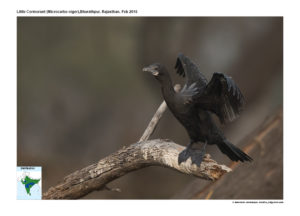Little Cormorant

Little Cormorant Phalacrocorax niger
Etymology:
- Phalacrocorax : Latin word phalakros – bald-headed ; korax – raven
- Niger : Latin word for “Black”
Vernacular Names: Hindi: Paan-kowwa, Jograbi, Sans: Laghoo jalkak, Pun: Jal kan, Ass: Pani kaori, Ben: Paan kawri, Guj: Nano jal kagdo, Nano kajiyo, Mar: Chota pankawla, Ta: Neer kagam, Te: Neetikaki, Chinna neeti kaki, Mal: Kakkataravu, Kan: Putta neeru kaage, Sinh: Diya kawa
Distribution in India: Wide spread resident in India
Description: Size of 45-51 cm. Breeding adult has black or brownish-black plumage, with small, often flattened, erectile crest on forecrown; in early breeding season has some scattered white filoplumes, mostly on head; feathering on lores and around eye has noticeable white dots; most of body plumage has bluish-green to blackish-purple sheen, mantle almost uniform, scapulars and wing-coverts largely blackish grey to silvery grey with black fringes affording scaly appearance; remiges and tail blackish; as breeding season progresses, head and upper neck may become dark chestnut; non-breeding adult duller, slightly brownish especially on head and neck, contrastingly white on anterior face from below gape to throat, sheen on scapulars and wing-coverts perhaps more greenish than silvery; iris blackish, bill is black or blackish grey, usually with horn-coloured tip, gape and base of mandible often bluish, later paler horn with greyish-blue base, gular pouch pale flesh; legs and feet blackish grey, webs tinged dusky pinkish or dusky brownish. Both sexes are alike.
Habitat: It is found in freshwater bodies in lowlands, including ponds, rivers, lakes, swamps, canals and rice fields. Also occurs on coasts, in estuaries and mangroves. Typically breeds in trees or bushes in flooded areas
Food Habits:They eat small freshwater fish; also frogs and tadpoles. They tend to forage mainly in small loose groups and are often seen foraging alone. They swim underwater to capture their prey, mainly fish. They propel themselves underwater using their webbed feet. Captured fishes are often brought up to the surface to swallow them and during this time other birds including other little cormorants, painted storks, gulls and egrets may attempt to steal them.Little cormorants tend to fish communally in larger groups. Like all other cormorants, they will emerge from water and will hold out their wings and stay immobile for a while. The behaviour has been suggested to be for wing-drying
Breeding Habits: The breeding season of the little cormorant is between July to September in northern India and November to February in southern India. Males display at the nest site by fluttering their wings while holding their head back and bill raised. They then lower the bill, and after pairing the male also provides food to the female in courtship feeding. Both parents take part in building the nest, which is a platform of sticks placed on trees and sometimes even on coconut palms. They may nest beside Indian pond herons and little egrets in colonies. The nest is built in about two weeks. The clutch size can vary from two to six eggs laid at intervals of about two days. The eggs hatch after 15 to 21 days. The young birds are able to leave the nest after about a month
.